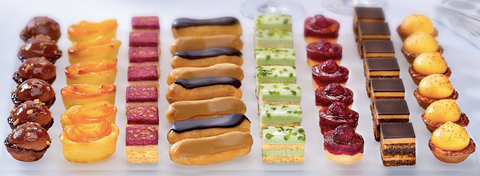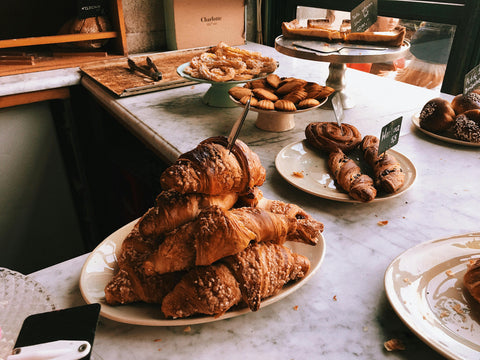Share
France is world-renowned for the richness of its gastronomy, and cheeses are one of its most iconic symbols. With over 1,000 varieties, ranging from soft cheeses to hard cheeses, washed rind to blue cheeses, each region of France offers its own unique specialties. This journey into French cheeses will unveil the stories, craftsmanship, and best ways to enjoy these gourmet treasures.
1. The Different Categories of French Cheeses
French cheeses are generally divided into several main families, each with distinct characteristics:
• Soft-ripened cheeses: Like the famous Brie de Meaux or Camembert de Normandie, these cheeses have a creamy texture and a thin rind, often white, developed naturally by mold.
• Washed rind cheeses: Stronger in aroma, like Munster or Epoisses, these cheeses have their rinds regularly washed with salted water or local spirits, giving them a more intense and pronounced flavor.
• Pressed cooked cheeses: Among them are cheeses like Comté or Beaufort, which are aged for longer periods and offer a firmer texture, often with hints of hazelnut and caramel.
• Blue-veined cheeses: Famous blue cheeses like Roquefort, Bleu d’Auvergne, or Fourme d’Ambert get their unique flavor from the mold that develops inside, giving them a strong and salty taste.
• Goat cheeses: Typical of regions like the Loire Valley, goat cheeses such as Crottin de Chavignol or Selles-sur-Cher can be enjoyed fresh for a mild taste, or aged for a more pronounced flavor.
2. A Terroir-Based Craft
Each cheese reflects its terroir, a deeply cherished concept in France that links the characteristics of a product to the region where it is made. The climate, soil, and even local flora influence the flavor of the milk and, therefore, the cheese. This is why a Reblochon from Savoie, made in the mountains, will have flavors of hay and fresh grass, while a Camembert evokes the damp pastures of Normandy.
3. The Secrets of Aging
Aging is a crucial step that gives cheese its unique taste and texture. Some cheeses, like Brie de Meaux, are aged for just a few weeks, while others, like Comté, can spend several years in a cellar. The longer the aging process, the more complex the aromas and the creamier the texture becomes.
Affineurs, or cheese ripening experts, carefully monitor the maturation of the cheese. They control the temperature, humidity, and often turn the cheeses to ensure even flavor development. Some cheeses are rubbed or washed during aging to develop richly flavored rinds.
4. How to Enjoy Cheese the French Way
In France, cheese is traditionally enjoyed at the end of a meal, often after the main course and before dessert. Here are some tips for an optimal tasting experience:
• Order of tasting: It’s best to start with milder cheeses (like fresh goat cheeses or brie) and work your way toward stronger ones, like blue or washed rind cheeses.
• Ideal temperature: Cheese should be eaten at room temperature to reveal its full flavors. Be sure to take it out of the fridge about an hour before serving.
• Accompaniments: Cheese is often paired with bread (baguette or country bread) and sometimes with dried fruits or jams to balance the flavors. Nuts, grapes, or figs pair wonderfully with blue cheeses, while fig or onion jams complement a good goat cheese.
5. Wine Pairings: The Perfect Harmony
Another secret to elevating French cheeses lies in pairing them with the right wine. Here are some suggestions for perfect pairings:
• A crisp Sauvignon Blanc with a Crottin de Chavignol.
• A Vin de Savoie to accompany a Reblochon.
• A Chardonnay or Vin Jaune from Jura to enhance a Comté.
• A light red wine, like Beaujolais, with a Brie de Meaux.
• For blue cheeses like Roquefort, a sweet wine like Sauternes creates a delightful sweet-salty contrast.
6. Where to Find the Best French Cheeses?
If you want to discover French cheeses in all their diversity, artisan cheese shops and markets are the best places to go. Places like Maison Androuet in Paris or La Fromagerie Barthélémy offer an incredible selection and expert advice to help you choose the perfect cheese.
French cheese is much more than just a treat. It’s a symbol of culture, tradition, and craftsmanship passed down through generations. By understanding the secrets behind each cheese, you can not only enhance your tasting experience but also appreciate the richness of a unique culinary heritage. So, why not indulge in a cheese platter and embark on a flavor journey through France?
1. The Different Categories of French Cheeses
French cheeses are generally divided into several main families, each with distinct characteristics:
• Soft-ripened cheeses: Like the famous Brie de Meaux or Camembert de Normandie, these cheeses have a creamy texture and a thin rind, often white, developed naturally by mold.
• Washed rind cheeses: Stronger in aroma, like Munster or Epoisses, these cheeses have their rinds regularly washed with salted water or local spirits, giving them a more intense and pronounced flavor.
• Pressed cooked cheeses: Among them are cheeses like Comté or Beaufort, which are aged for longer periods and offer a firmer texture, often with hints of hazelnut and caramel.
• Blue-veined cheeses: Famous blue cheeses like Roquefort, Bleu d’Auvergne, or Fourme d’Ambert get their unique flavor from the mold that develops inside, giving them a strong and salty taste.
• Goat cheeses: Typical of regions like the Loire Valley, goat cheeses such as Crottin de Chavignol or Selles-sur-Cher can be enjoyed fresh for a mild taste, or aged for a more pronounced flavor.
2. A Terroir-Based Craft
Each cheese reflects its terroir, a deeply cherished concept in France that links the characteristics of a product to the region where it is made. The climate, soil, and even local flora influence the flavor of the milk and, therefore, the cheese. This is why a Reblochon from Savoie, made in the mountains, will have flavors of hay and fresh grass, while a Camembert evokes the damp pastures of Normandy.
3. The Secrets of Aging
Aging is a crucial step that gives cheese its unique taste and texture. Some cheeses, like Brie de Meaux, are aged for just a few weeks, while others, like Comté, can spend several years in a cellar. The longer the aging process, the more complex the aromas and the creamier the texture becomes.
Affineurs, or cheese ripening experts, carefully monitor the maturation of the cheese. They control the temperature, humidity, and often turn the cheeses to ensure even flavor development. Some cheeses are rubbed or washed during aging to develop richly flavored rinds.
4. How to Enjoy Cheese the French Way
In France, cheese is traditionally enjoyed at the end of a meal, often after the main course and before dessert. Here are some tips for an optimal tasting experience:
• Order of tasting: It’s best to start with milder cheeses (like fresh goat cheeses or brie) and work your way toward stronger ones, like blue or washed rind cheeses.
• Ideal temperature: Cheese should be eaten at room temperature to reveal its full flavors. Be sure to take it out of the fridge about an hour before serving.
• Accompaniments: Cheese is often paired with bread (baguette or country bread) and sometimes with dried fruits or jams to balance the flavors. Nuts, grapes, or figs pair wonderfully with blue cheeses, while fig or onion jams complement a good goat cheese.
5. Wine Pairings: The Perfect Harmony
Another secret to elevating French cheeses lies in pairing them with the right wine. Here are some suggestions for perfect pairings:
• A crisp Sauvignon Blanc with a Crottin de Chavignol.
• A Vin de Savoie to accompany a Reblochon.
• A Chardonnay or Vin Jaune from Jura to enhance a Comté.
• A light red wine, like Beaujolais, with a Brie de Meaux.
• For blue cheeses like Roquefort, a sweet wine like Sauternes creates a delightful sweet-salty contrast.
6. Where to Find the Best French Cheeses?
If you want to discover French cheeses in all their diversity, artisan cheese shops and markets are the best places to go. Places like Maison Androuet in Paris or La Fromagerie Barthélémy offer an incredible selection and expert advice to help you choose the perfect cheese.
French cheese is much more than just a treat. It’s a symbol of culture, tradition, and craftsmanship passed down through generations. By understanding the secrets behind each cheese, you can not only enhance your tasting experience but also appreciate the richness of a unique culinary heritage. So, why not indulge in a cheese platter and embark on a flavor journey through France?



